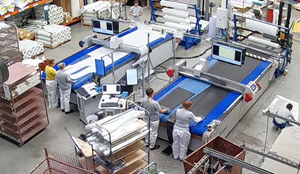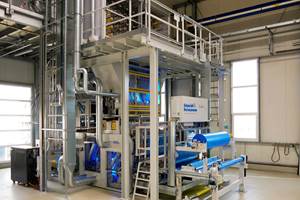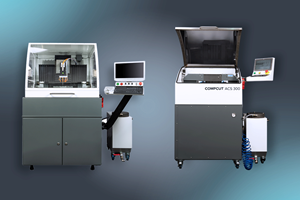Q&A: Manish Patel and Ashley Graeber of Web Industries
CW Talks: The Composites Podcast speaks with Manish Patel, senior application engineer, and Ashley Graeber, director of sales and business development, about Web Industries’ place in the composites supply chain.
Editor’s note: CW Talks: The Composites Podcast, recently spoke with Patel, senior application engineer, and Graeber, director of sales and business development, about Web Industries (Marlborough, MA, US) and its place in the composites supply chain as a slitter of carbon and glass fiber tapes into smaller tows, and as a provider of cutting and kitting services. Patel explores the company’s technical expertise, while Graeber reviews the company’s commercial presence. What follows is excerpted from the podcast. To hear the complete interview, check out CW Talks on iTunes or Google Play, or at CompositesWorld.com/podcast.
CW: Let’s talk about Web Industries itself. Where does it fit into composites manufacturing and into the composites supply chain?
AG: Interesting question. We’ve played a valuable role in the industry, but outside our immediate customer base, which is fairly narrow, we are not that well known. We spent the last 20-plus years pioneering our product development and working with formatting solutions, mostly with a small group of customers. We’re working actively to broaden our market awareness and perception, with expansion of our facilities and services globally.
CW: The core of Web’s business, its legacy, is slitting of prepregs for automated fiber and tape placement. What are the challenges associated with slitting?
MP: First, we love challenges, it’s true. It’s not just about slitting and spooling up on the core. Each carbon fiber and resin mix behaves and processes differently, with a different temperature and humidity needed when we are processing. I would say our biggest challenge concerns projects that use a hand layup product and transitioning that product to automated fiber placement layup.… Hand layup products tend to be overly tacky, and are not optimized for AFP processing.
AG: To add to what to Manish said, the commercial challenge is just that: We just slit fabric, and how hard can it possibly be …. I’ve actually heard that quite a few times. But as Manish said, most manufacturers don’t understand the value impact that precision-slit, custom-spooled tape can have on their manufacturing process. In the early stages, it can reduce time to market, and during the production life cycle, it’s all about ongoing increased equipment uptime and production throughput.
CW: As the two of you look to the future of aerospace composites, what opportunities do you see from a technical and from a commercial perspective?
MP: Currently we’re heavily involved with thermoplastics processing. This is not a new product, but it’s going to play a significant role in the future. We believe the market will see more material types being used on future aircraft as engineers optimize the parts based on the material itself … regardless of the material type and processing method…we want to provide a solution path to make parts in the most efficient way.
AG: From a commercial perspective, I’m excited about the prospects, for both Web and the aerocomposites industry, so definitely a bright future … we’ve opened a thermoplastics center of excellence and are working diligently with our key customers on some various formatting disciplines specific to thermoplastics.
CW: As you look over this industry and as you look back on your experience, what is your assessment of the future of the composites industry?
AG: Our worries are the same as any industry that’s healthy, and that’s that we have huge production volumes, growth in production volumes, which bring price pressures, supply chain challenges. You mentioned thermoplastics — there’s the availability of material to drive that industry, and also the standard competitive pressures … just looking at the different design options that composites allow, and the growing adoption of composites across all those industry segments … it’s really hard not to be excited.
MP: From the technical side, the dynamic nature of the business is not new. During our 50 years’ history in the formatting business, we have seen many changes. We fully expect that the composites industry will continue to evolve and mature with the changes that we don’t fully see today …. We fully expect that in 10 to 15 years our service model for this market will look very different than what it is today.Related Content
Eastman Machine automated cutting equipment increases HanseYacht efficiencies by 85%
Since implementation of its first conveyorized cutting system, the recreational boatbuilder regularly seeks ways to improve its composite material handling processes.
Read MoreOptimized, automated manufacturing concepts for composite parts, SMC semi-finished materials
JEC World 2024: The AutoCut Pick&Place and Cube SMC line from Schmidt & Heinzmann aim to deliver more modernized manufacturing capabilities with improved efficiency and process control.
Read MoreState-of-the-art composites cutting, machining solutions ensure accuracy, ease of operation
JEC World 2024: Compcut is presenting its advanced composites saw (ACS) and precision composite router (PCR), in addition to inviting attendees to bring their own materials for demonstration purposes.
Read MoreInnoptus Solar Team uses Jetcam software to optimize production of solar vehicle
The world title-holding, Belgium racing team is producing its tenth composites-intensive solar car using Jetcam Expert nesting software.
Read MoreRead Next
From the CW Archives: The tale of the thermoplastic cryotank
In 2006, guest columnist Bob Hartunian related the story of his efforts two decades prior, while at McDonnell Douglas, to develop a thermoplastic composite crytank for hydrogen storage. He learned a lot of lessons.
Read MoreComposites end markets: Energy (2024)
Composites are used widely in oil/gas, wind and other renewable energy applications. Despite market challenges, growth potential and innovation for composites continue.
Read MoreCW’s 2024 Top Shops survey offers new approach to benchmarking
Respondents that complete the survey by April 30, 2024, have the chance to be recognized as an honoree.
Read More

























